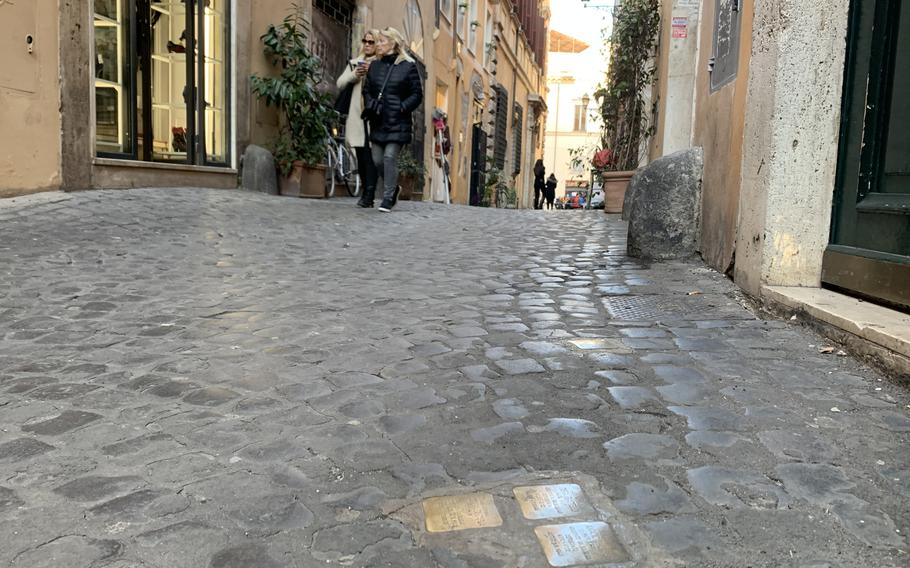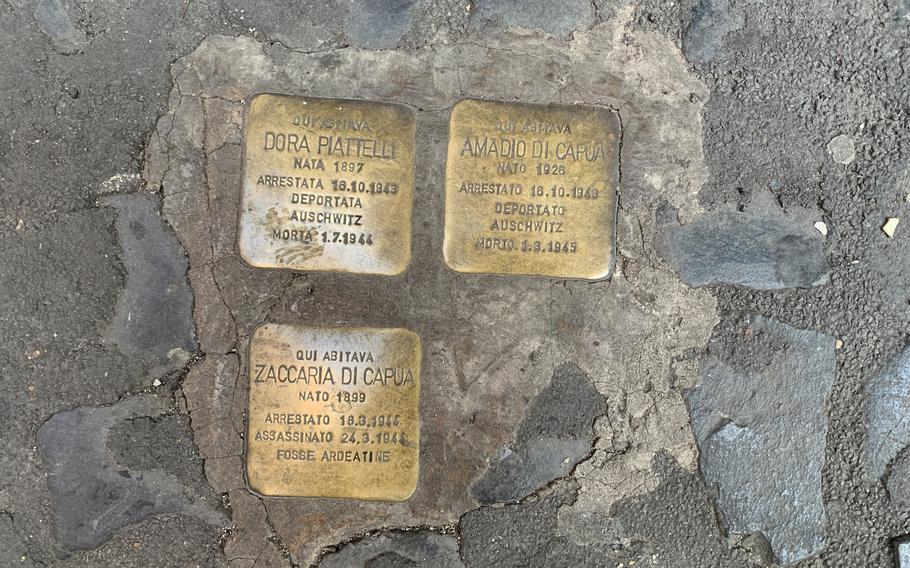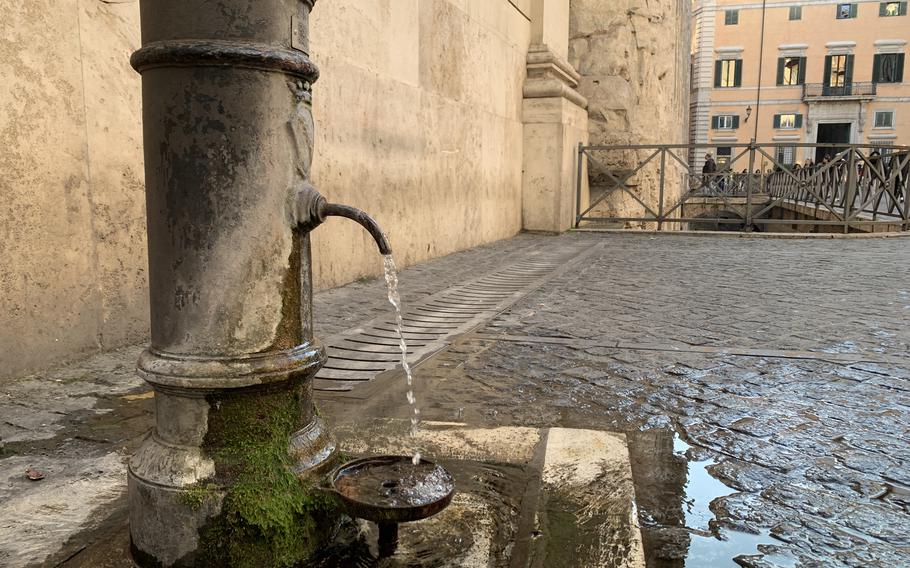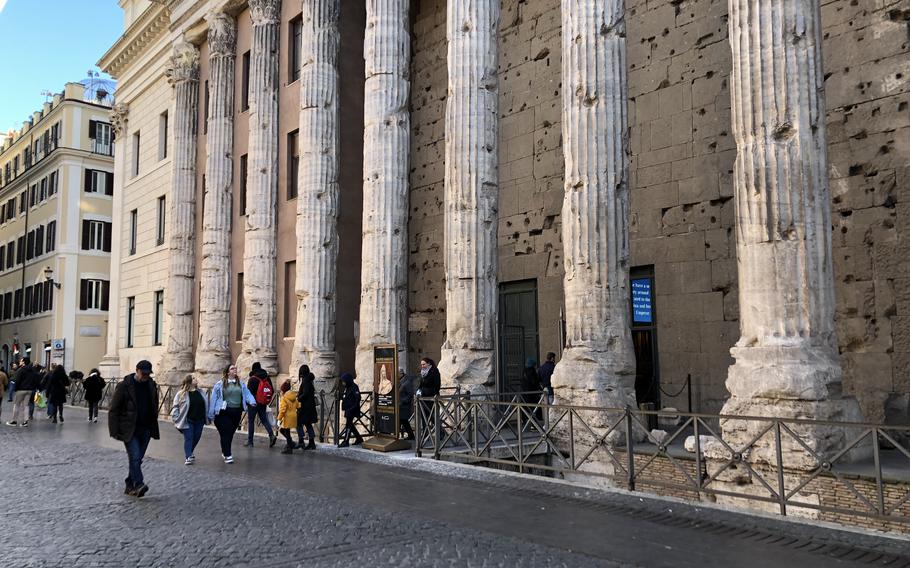
Bronze stumbling stones in memorial to Roman Jews murdered in the Holocaust are seen throughout Rome's Jewish Ghetto and in other parts of the city. (Alison Bath/Stars and Stripes)
For many tourists, a day in Rome means seeing the Sistine Chapel, visiting the Colosseum or climbing the famed Spanish Steps.
But along the well-worn cobblestone streets to and from those and other Roman wonders are a plethora of often overlooked treasures that reveal other facets of the Eternal City.
Finding them can be difficult unless you know where to look. We’ve compiled five below, but more about these and others can be found at online travel sites such as @livevirtualguide on Instagram.

These bronze pietre d’inciampo, or stumbling stones, placed near homes in Rome's Jewish Ghetto memorialize victims of the Holocaust. The stones can be seen throughout the ghetto and in other locations in Rome. (Alison Bath/Stars and Stripes)
Pietre d’inciampo, or stumbling stones, in the Jewish Ghetto, Via della Reginella
These bronze cobblestones placed throughout the ghetto, and in other locations in Rome, are in front of the homes of Holocaust victims.
Each stone bears the victim’s name, birth year, date of arrest, the Nazi concentration camp they were taken to and the date of their death. Called stolpersteine in German, such memorials can also be found in Germany, Austria and elsewhere.
Also visit: The Jewish Museum, which includes the Great Synagogue of Rome, boasting the city’s only square dome. At the end of Via della Reginella just outside the ghetto, you can see the late Renaissance-era Turtle Fountain.
Passeto del Biscione
This covered passageway leading from Via di Grotta Pinta to Piazza Biscione is just steps away from where Julius Caesar was assassinated in 44 B.C.
The entrance to the walkway may seem off-putting, but don’t let it keep you from stepping inside to see the recently restored frescoes with cherubs, garlands and a blue sky that line the ceiling and upper walls.
There also is a shrine to the Madonna at one end of the short passageway, thought to be originally part of the Theater of Pompey, completed in 55 B.C.
Also visit: Campo de Fiori’s market, with fruit and vegetables, flowers and other items. Skip the restaurants that line the piazza and head to Roscioli at Via del Giubbonari 21. The salumeria/cucina has an extensive wine cellar and offers some of the city’s best cacio e pepe.
Fountain of Lovers at Trevi Fountain
This small but charming font is situated to the right of the heavily visited Trevi Fountain, nestled alongside a stone wall toward the back.
According to legend, young lovers who were to be separated, often because of military service, would drink from the Fountain of Lovers, with its two arcing waterspouts, to remain forever faithful and in love.
The fountain also had a practical purpose: allowing residents access to the waters of the Acqua Vergine aqueduct, according to the website Waidy Wow.
Also visit: Vicus Caprarius, or City of Water, at Vicolo del Puttarello 25 for an underground look at how the Trevi Fountain is fed. The archaeological site features an ancient Roman apartment complex beneath the Trevi district.
Galleria Sciarra, Via Marco Minghetti, 10
With just a minute or two of walking from the Trevi Fountain, you can take in the ornate frescoes and architecture in the hidden courtyard of this Art Nouveau building dating to the late 19th century, according to the travel blog My Adventures Across the World.
Among the building’s features are frescoes in the Liberty style, an Italian variant of Art Nouveau. Mostly depicting women, they were painted by Giuseppe Cellini in 1887, according to the blog.
At the top of the building some four stories above is a glass-and-iron canopy that allows light into the courtyard, which is a public passageway today.
Also visit: IKONO, an interactive art gallery for people of all ages featuring more than 12 immersive activities, including a ball pit, a hall of lanterns and a maze of mirrors and lights.
The gallery, at Via del Seminario 111, is a four-minute walk from the Galleria and is also near the Pantheon.

Public water fountains, such as this one in front of Rome's Hadrianeum, offer fresh, clean drinking water to passersby. There are more than 2,500 of the fountains, called nasoni, in the city. (Alison Bath/Stars and Stripes)
Nasoni
There are more than 2,500 of these public fountains, some quite grand and artistic, throughout Rome. Many of them are in the city’s historic center, according to the blog Wanted in Rome.
For example, there is one in front of the Hadrianeum, an ancient Roman temple near the Pantheon, dedicated in the year 145.
These fountains, which run constantly, offer clean drinking water for residents and visitors alike, making it unnecessary to buy bottled water during your visit.
Simply fill up with the same water pumped into Roman homes. Bonus: a small trough below the spigot allows dogs to drink.

Rome's Hadrianeum, a temple dedicated in 145 C.E., is free and open on weekdays, offering an immersive experience to see events at the temple over time. (Alison Bath/Stars and Stripes)
Also visit: The free immersive exhibit at the Hadrianeum at Piazza di Pietra, open to the public from 1-5 p.m. weekdays. A 22-minute film takes viewers through time, retracing events that happened at the temple.
Much of the original structure is gone but elements of its facade, including 11 Corinthian-style columns, remain. The modern building behind them is home to the city’s chamber of commerce, according to www.turismoroma.it/en/events/hadrianeum.